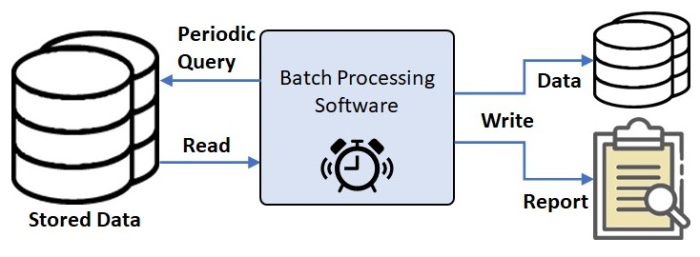
 Data Structure
Data Structure Networking
Networking RDBMS
RDBMS Operating System
Operating System Java
Java MS Excel
MS Excel iOS
iOS HTML
HTML CSS
CSS Android
Android Python
Python C Programming
C Programming C++
C++ C#
C# MongoDB
MongoDB MySQL
MySQL Javascript
Javascript PHP
PHP
- Selected Reading
- UPSC IAS Exams Notes
- Developer's Best Practices
- Questions and Answers
- Effective Resume Writing
- HR Interview Questions
- Computer Glossary
- Who is Who
Difference between Batch Processing and Stream Processing
Computer systems have been handling data since decades, but the volume and speed of handling has become phenomenal in the last few years. Data processing means "the collection and manipulation of items of data to produce meaningful information", has been evolving in terms of speed, efficiency, and leveraging the computing resources, till date.
In this article, we will see two important techniques of data processing in the field of computation ? Batch processing and Stream processing. We will elaborate them in detail and see how they are different.
What is Batch Processing?
Batch processing is technique of processing large amount of data of repetitive type that does not need human intervention to process.
Batch processes are automatic. Human intervention is minimal in Batch processing; it is not required except at the time of submitting the batch until the batch processing is complete. Batch processing is executed on finding idle system time, in the background, at a scheduled time such as after-office hours or overnight, or on demand-basis.
The following diagram shows an overview of how Batch processing works ?

Advantages of Batch Processing
The prominent advantages of Batch processing are ?
Cost Savings ? No need of hiring data-entry clerks hence saving on operational and labor costs.
Optimum Utilization of Resources ? Since Batch processing can be handled without hampering the primary tasks of computation in an organization. Batch processing doesn't require anything out of the processing software hence the processing resources are used at optimum.
Hands-free Managerial Control ? The managers don't need to worry about competition of batches as the software sends exception notifications to appropriate person in case any problem. Once the software is set properly, there is nothing much required to be done. Hence managers can trust and rely on batch processing software completely.
Accuracy ? Due to its automated nature, Batch processing avoids data errors completely.
Challenges in Batch Processing
Batch processing incurs the following challenges ?
Difficult troubleshooting ? Debugging and troubleshooting of Batch processing needs expert professionals having domain knowledge.
Training costs ? Businesses need to invest in personnel training on Batch processing software. The initial investment on training is high.
Usage of Batch Processing
Batch processing can be effectively used to process large amount of data processing is required. It is used to ?
generate employee payroll data for a month
execute bank transactions done over a week's time
generating periodic reports
generating credit card transaction on monthly basis
generating annual financial report of an organization
in highly complex computing environments, the researchers can submit batches of complex calculations related to science.
You can consider Batch processing in the following scenarios ?
you identify the tasks that are going to be repetitive and can be executed automatically
large volume of data is required to process
real time inputs or response is not crucial, the processing can wait
What is Stream Processing?
Stream processing is a technique in which a continuous stream of data is processed for immediate use, or for analyzing, filtering, combining, or modifying rapidly. The data is typically acted upon when it was created. The continual influx of data is termed as the "data stream". Stream processing involves three stages namely, Data acquisition, Data Processing, and Data Delivery.
The following diagram depicts Stream processing works ?

Advantages of Stream Processing
The most prominent advantage of Stream processing is that there is no latency. In stream processing, data is fed to the streaming software in very small chunks or "micro-batches". Hence the data analysis can be done in nearly-real-time streaming and the insights are available almost immediately. This feature of streaming enables the businesses to make quick decisions.
Challenges in Stream Processing
Stream processing incurs the following challenges ?
Alignment of streaming software and hardware ? as streaming requires high amount of data to handle, the streaming software and the hardware need to be attuned.
Speed of execution ? If data influx is slow, the performance of a streaming software can get volatile.
Usage of Stream Processing
Stream processing is inevitable where a continual data ingestion is required, such as ?
- Air-traffic information
- Digital product's user experience (UX) monitoring
- Weather forecasting
- Mapping of customers' journey
- Stock market trading
- Fraud detection
- Flood detection
- Cybersecurity
You can consider Stream processing in the scenarios when ?
data is not required to be stored
data is available in real time, in a constant flow for instantaneous use
the events in the scene are occurring too frequently
Differences between Batch and Stream Processing
Batch and Stream processing techniques are different in the following ways ?
| Key Factor | Batch Processing | Stream Processing |
|---|---|---|
| Infrastructure Complexity | Less complex as it does not need constant data entry or unique hardware support. | Complex than Batch processing |
| Data Size | Works best for large data chunks. | It handles very small data chunks. |
| Occurrence of Processing | Data processing takes place on the data which is stored over some time. | Data processing takes place immediately. |
| Knowledge of Data Size before processing | The data size is known or can be anticipated in advance. | The data size is neither known in advance nor can be anticipated. |
| Time Required for Data Processing | Long, typically in minutes or hours, or even days, depending upon the Batch size. | Short, typically in seconds or milliseconds. |
| Provision of Response | On completing the Batch Processing operation. | Almost immediately. |
| Storage Space Requirement | Large storage space is required for this processing. | Less storage is required only for processing small data. |
Conclusion
Batch and Stream processing are types of data processing in the domain of computation, each has its own strengths and weaknesses. Companies have realized that choosing the right mix of Batch and Stream processing is beneficial as a computing choice for their operational workflows. Companies can use each technique by identifying the criticality involved in handling the data and the types of tasks in hand.

